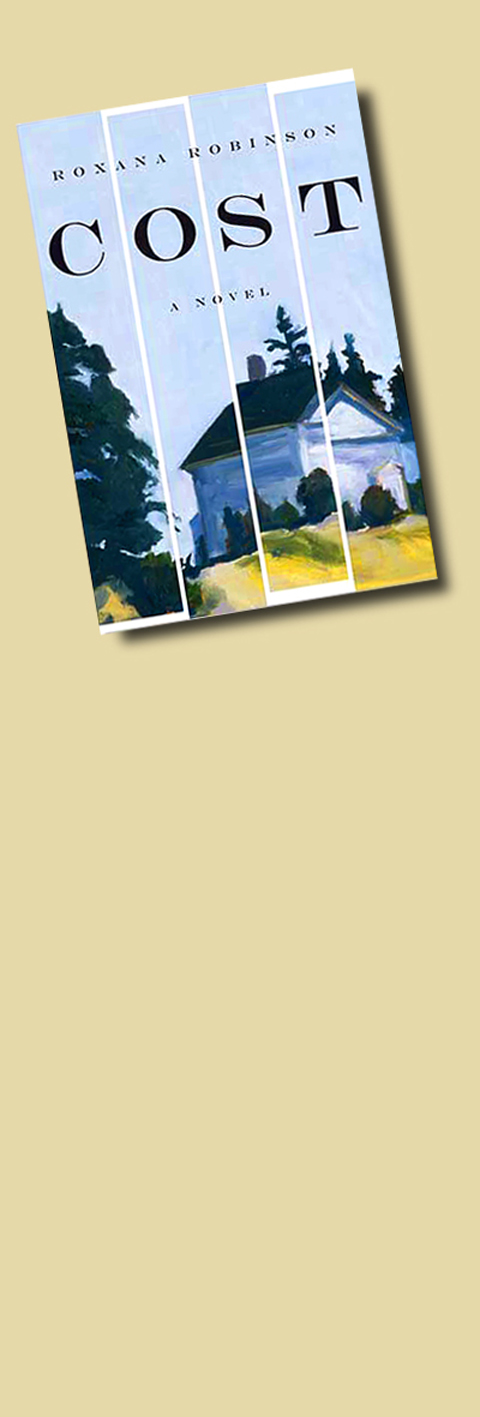Among the ways children can torture their parents, shooting heroin has to be near the top.
The 22-year-old junkie in Roxana Robinson’s fourth novel, Cost, is Jack Lambert, younger son of Julia Lambert, a landscape painter and teacher at Columbia who keeps a house in Maine, where most of the action takes place. The novel is told from several points of view; Julia’s is the main one.
When it opens, Julia’s elderly parents are up on a visit. Her father, a retired neurosurgeon, is an ogre of Wasp disapproval who has passed his emotional stinginess on to his children and grandchildren. Her mother is fading away into Alzheimer’s.

As soon as Julia and her ex-husband find out about Jack’s habit, they lure him from New York to Maine for an intervention and rope the rest of the family — including Jack’s older brother and Julia’s angry sister — into participating. Ignoring professional warnings to have a counselor present, they confront Jack about his drug use. Then all hell breaks loose.
An estranged family thrown together under the pressure of a crisis is a beautiful setup for black comedy, as Tracy Letts just demonstrated in his Broadway hit August: Osage County. But Robinson has no interest in comedy, or in melodrama, either.
She refuses to appeal to our baser impulses. Instead she insists on letting events grind forward in an ache of glum veracity. You can’t help admiring her integrity, but that isn’t the same as enjoying it. There’s a lot to be said for a little trashiness.
My own alarm bells went off early, when Julia opens her refrigerator, “leaning into its chilly radiance,” and slices a tomato, “opening its juicy scarlet core.” Since I already know what the insides of a refrigerator and a tomato are like, these very standard descriptions just seemed like a way of making sentences longer.
Such padding, on a larger scale, takes up the first half of the novel. Robinson expends thousands of words delineating the many injuries and cross-resentments that have everybody in the family seething about something. She exhausts herself establishing beyond the shadow of a doubt that Jack really and truly is a junkie when one glimpse of the tracks on his arms would do the trick. It takes her 150 pages to get him to Maine.
A more instinctive dramatist would have started the book at this point and then filled in what we need to know as the story zipped along. Cost doesn’t zip, though to be fair it doesn’t lumber, either. It advances with grim implacability toward its melancholy goal.
Awakened at last to the fury of her son’s habit, Julia keeps uttering variations on “I hate this” and “I don’t want to hear this.” After a while I didn’t, either. I wasn’t having fun and I wasn’t learning anything new about addiction or Wasp frigidity. At the same time, I couldn’t shield myself from the intensity of what I was reading.
In fact, Robinson makes only one significant misstep once she finally gets the story going. Following the intervention and its disastrous coda, she sticks in a long irrelevant chapter about an art opening of Julia’s, making us privy to Julia’s interior lament over her fate as a respected but not all that successful painter — transparent code for a midlist novelist.
Like Julia, Robinson works with traditional technical means, and while I might be interested in learning what she has to say about them somewhere else, dramatically and thematically her thoughts are out of place here. They’re the only thing in the novel that seriously clunks.
Though I don’t love what she does in the rest of the book, I recognize the deftness with which she pulls it off. Even if being moved by Cost feels less like responding to a work of art than reacting to an awful story you might read in a magazine while waiting for your groceries to be rung up, there’s no denying the author’s skill.

That US assistance was a model for Taiwan’s spectacular development success was early recognized by policymakers and analysts. In a report to the US Congress for the fiscal year 1962, former President John F. Kennedy noted Taiwan’s “rapid economic growth,” was “producing a substantial net gain in living.” Kennedy had a stake in Taiwan’s achievements and the US’ official development assistance (ODA) in general: In September 1961, his entreaty to make the 1960s a “decade of development,” and an accompanying proposal for dedicated legislation to this end, had been formalized by congressional passage of the Foreign Assistance Act. Two

March 31 to April 6 On May 13, 1950, National Taiwan University Hospital otolaryngologist Su You-peng (蘇友鵬) was summoned to the director’s office. He thought someone had complained about him practicing the violin at night, but when he entered the room, he knew something was terribly wrong. He saw several burly men who appeared to be government secret agents, and three other resident doctors: internist Hsu Chiang (許強), dermatologist Hu Pao-chen (胡寶珍) and ophthalmologist Hu Hsin-lin (胡鑫麟). They were handcuffed, herded onto two jeeps and taken to the Secrecy Bureau (保密局) for questioning. Su was still in his doctor’s robes at

Last week the Democratic Progressive Party (DPP) said that the budget cuts voted for by the China-aligned parties in the legislature, are intended to force the DPP to hike electricity rates. The public would then blame it for the rate hike. It’s fairly clear that the first part of that is correct. Slashing the budget of state-run Taiwan Power Co (Taipower, 台電) is a move intended to cause discontent with the DPP when electricity rates go up. Taipower’s debt, NT$422.9 billion (US$12.78 billion), is one of the numerous permanent crises created by the nation’s construction-industrial state and the developmentalist mentality it

Experts say that the devastating earthquake in Myanmar on Friday was likely the strongest to hit the country in decades, with disaster modeling suggesting thousands could be dead. Automatic assessments from the US Geological Survey (USGS) said the shallow 7.7-magnitude quake northwest of the central Myanmar city of Sagaing triggered a red alert for shaking-related fatalities and economic losses. “High casualties and extensive damage are probable and the disaster is likely widespread,” it said, locating the epicentre near the central Myanmar city of Mandalay, home to more than a million people. Myanmar’s ruling junta said on Saturday morning that the number killed had